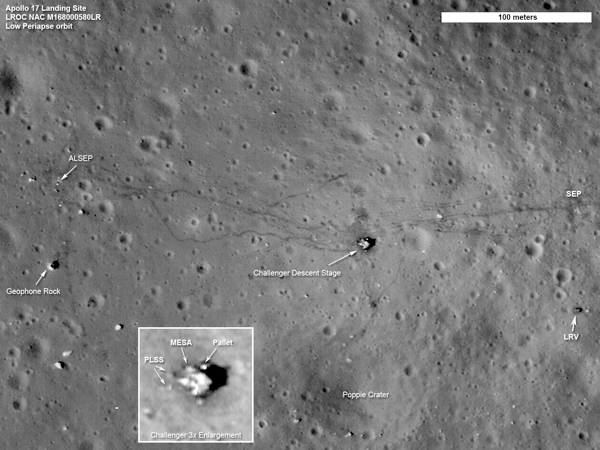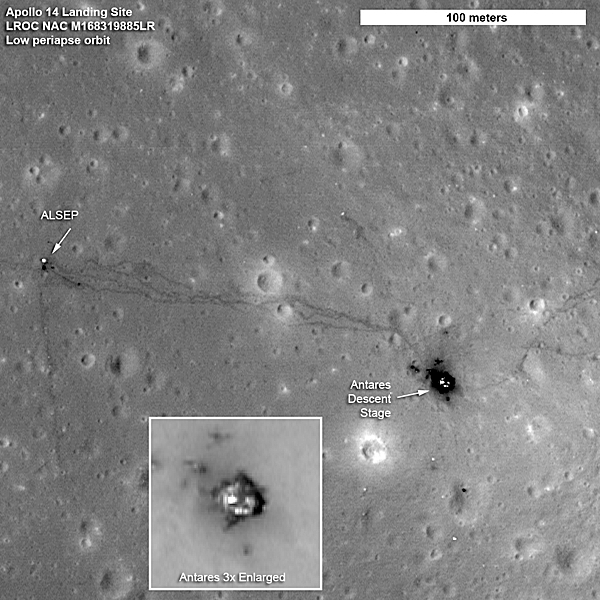Lunar orbiter beams back closeup views of Apollo landing sites
By WILLIAM HARWOOD
CBS News
NASA unveiled new closeup views of three Apollo landing sites Tuesday, shot by the agency's Lunar Reconnaissance Orbiter from an altitude of just 13 miles or so, clearly showing the footprints of visiting astronauts, the lower stages of the three lunar landers, experiment packages left on the moon's surface and the tracks left behind by a dune buggy-like rover.
"The new low-altitude Narrow Angle Camera images sharpen our view of the moon's surface," Mark Robinson, principal investigator for the Lunar Reconnaissance Orbiter Camera, said in a statement. "A great example is the sharpness of the rover tracks at the Apollo 17 site. In previous images the rover tracks were visible, but now they are sharp parallel lines on the surface."
Photographing the moon from an altitude of just 13 miles posed a challenge because of the spacecraft's velocity. At a speed of about 3,668 mph, the spacecraft moved about 20 inches during a best-case 330-microsecond exposure, Robinson said in a teleconference with reporters. As a result, the images are slightly blurred in the direction of travel.
The Lunar Reconnaissance Orbiter was launched on June 18, 2009, to help NASA map out possible landing sites for future manned missions. Last September, the spacecraft began science observations at an altitude of about 31 miles, allowing its narrow-angle camera to detect surface features as small as 20 inches across.
But the orbit was adjusted earlier this summer to lower the altitude to as little as 13 miles up. Operating at that low altitude for the past 28 days, LRO's narrow-angle camera was able to resolve objects as small as 10 inches across. At the landing sites for Apollo 12, 14 and 17, that improved resolution showed a multitude of features, including experiment packages left behind on the surface, the tracks left behind by the Apollo 17 lunar rover and the meandering trails of astronaut footprints.
Flight controllers planned to maneuver LRO back to a 31-mile-high orbit Tuesday. Later this year, the spacecraft will be moved into a fuel-conserving elliptical orbit with a low point of about 18 miles over the moon's south pole and a high point of about 124 miles above the north pole. While the Apollo landing sites likely will be imaged again down the road, future pictures will not have the resolution of the pictures released Tuesday.
CBS News
NASA unveiled new closeup views of three Apollo landing sites Tuesday, shot by the agency's Lunar Reconnaissance Orbiter from an altitude of just 13 miles or so, clearly showing the footprints of visiting astronauts, the lower stages of the three lunar landers, experiment packages left on the moon's surface and the tracks left behind by a dune buggy-like rover.
"The new low-altitude Narrow Angle Camera images sharpen our view of the moon's surface," Mark Robinson, principal investigator for the Lunar Reconnaissance Orbiter Camera, said in a statement. "A great example is the sharpness of the rover tracks at the Apollo 17 site. In previous images the rover tracks were visible, but now they are sharp parallel lines on the surface."
 |
| The Apollo 17 landing site, showing the Challenger descent stage, the lunar rover (LRV) and experiment packages deployed by the crew. Astronaut footprints and the parallel tracks of the rover are clearly visible. (NASA) |
Photographing the moon from an altitude of just 13 miles posed a challenge because of the spacecraft's velocity. At a speed of about 3,668 mph, the spacecraft moved about 20 inches during a best-case 330-microsecond exposure, Robinson said in a teleconference with reporters. As a result, the images are slightly blurred in the direction of travel.
The Lunar Reconnaissance Orbiter was launched on June 18, 2009, to help NASA map out possible landing sites for future manned missions. Last September, the spacecraft began science observations at an altitude of about 31 miles, allowing its narrow-angle camera to detect surface features as small as 20 inches across.
 |
| The Apollo 12 landing site, showing an unmanned Surveyor spacecraft near the rim of a nearby crater. (NASA) |
But the orbit was adjusted earlier this summer to lower the altitude to as little as 13 miles up. Operating at that low altitude for the past 28 days, LRO's narrow-angle camera was able to resolve objects as small as 10 inches across. At the landing sites for Apollo 12, 14 and 17, that improved resolution showed a multitude of features, including experiment packages left behind on the surface, the tracks left behind by the Apollo 17 lunar rover and the meandering trails of astronaut footprints.
 |
| The Apollo 14 landing site. (NASA) |
Flight controllers planned to maneuver LRO back to a 31-mile-high orbit Tuesday. Later this year, the spacecraft will be moved into a fuel-conserving elliptical orbit with a low point of about 18 miles over the moon's south pole and a high point of about 124 miles above the north pole. While the Apollo landing sites likely will be imaged again down the road, future pictures will not have the resolution of the pictures released Tuesday.